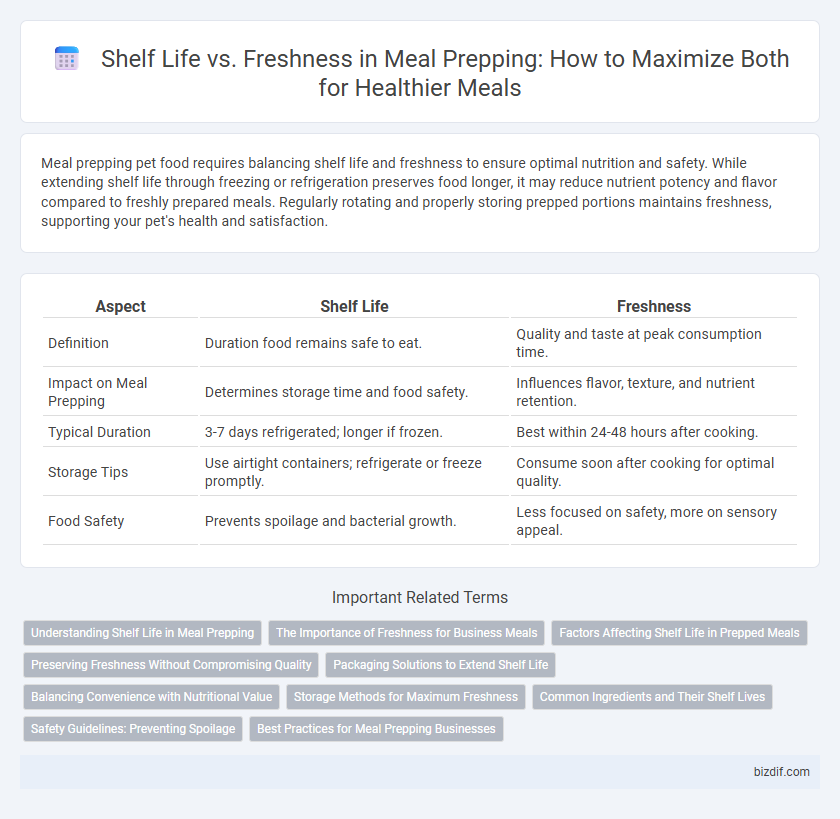Meal prepping pet food requires balancing shelf life and freshness to ensure optimal nutrition and safety. While extending shelf life through freezing or refrigeration preserves food longer, it may reduce nutrient potency and flavor compared to freshly prepared meals. Regularly rotating and properly storing prepped portions maintains freshness, supporting your pet's health and satisfaction.
Table of Comparison
| Aspect | Shelf Life | Freshness |
|---|---|---|
| Definition | Duration food remains safe to eat. | Quality and taste at peak consumption time. |
| Impact on Meal Prepping | Determines storage time and food safety. | Influences flavor, texture, and nutrient retention. |
| Typical Duration | 3-7 days refrigerated; longer if frozen. | Best within 24-48 hours after cooking. |
| Storage Tips | Use airtight containers; refrigerate or freeze promptly. | Consume soon after cooking for optimal quality. |
| Food Safety | Prevents spoilage and bacterial growth. | Less focused on safety, more on sensory appeal. |
Understanding Shelf Life in Meal Prepping
Understanding shelf life in meal prepping is crucial for maintaining both safety and quality of pre-prepared meals. The shelf life varies significantly depending on factors such as ingredient type, cooking method, and storage conditions, typically ranging from 3 to 7 days in a refrigerator. Proper knowledge of expiration times prevents food spoilage, reduces waste, and ensures meals retain optimal nutritional value and taste throughout the week.
The Importance of Freshness for Business Meals
Freshness directly impacts the flavor and nutritional value of business meals, influencing client satisfaction and repeat orders. Maintaining optimal shelf life while preserving freshness requires precise temperature control and timely ingredient sourcing. Prioritizing freshness ensures meals remain appealing, safe, and competitive in a professional food service environment.
Factors Affecting Shelf Life in Prepped Meals
Factors affecting shelf life in prepped meals include ingredient type, storage temperature, and packaging methods. High moisture foods and proteins typically have shorter shelf life due to microbial growth, while airtight containers and refrigeration extend freshness. Properly balanced pH levels and avoiding cross-contamination are essential to maintaining meal quality over time.
Preserving Freshness Without Compromising Quality
Proper meal prepping techniques extend the shelf life of ingredients while preserving their nutritional value and texture. Utilizing airtight containers, refrigeration at optimal temperatures, and vacuum sealing effectively maintain freshness without compromising quality. Incorporating natural preservatives such as lemon juice or vinegar can enhance longevity and flavor retention during storage.
Packaging Solutions to Extend Shelf Life
Vacuum-sealed packaging and airtight containers significantly extend the shelf life of meal-prepped dishes by minimizing oxygen exposure and preventing microbial growth. Incorporating materials with barrier properties such as multilayer films or oxygen absorbers further preserves freshness by inhibiting moisture and contamination. Utilizing portion-controlled, resealable packaging not only maintains optimal taste and texture but also reduces food waste through effective storage management.
Balancing Convenience with Nutritional Value
Maximizing meal prep shelf life extends food usability but can compromise freshness and nutrient density. Using airtight containers and refrigeration slows spoilage and preserves vitamins, while frequent rotation ensures meals retain flavor and texture. Striking a balance between convenience and optimal nutritional value enhances both meal satisfaction and health benefits.
Storage Methods for Maximum Freshness
Proper storage methods significantly extend meal prep shelf life while preserving freshness, with airtight containers and vacuum sealing minimizing exposure to oxygen and moisture. Refrigeration slows bacterial growth, keeping meals fresh up to four days, while freezing extends shelf life to several months without significant nutrient loss. Using appropriate containers, labeling with dates, and cooling meals before storage optimize freshness and reduce food waste.
Common Ingredients and Their Shelf Lives
Chicken breast typically stays fresh for 1-2 days in the refrigerator but can last up to 9 months when frozen, making it essential to balance meal prepping quantities with storage options. Vegetables like spinach and broccoli maintain optimal freshness for about 3-5 days refrigerated and up to 8-12 months when frozen, preserving nutrients and texture best within these time frames. Grains such as cooked rice and quinoa can be stored safely in the fridge for 4-6 days, while dry pantry stocks like uncooked rice or oats have significantly longer shelf lives, often exceeding one year when kept in airtight containers.
Safety Guidelines: Preventing Spoilage
Proper meal prepping requires strict adherence to safety guidelines to prevent spoilage and maintain freshness. Refrigerate meals within two hours of preparation and consume within 3 to 4 days to minimize bacterial growth. Use airtight containers and maintain a consistent refrigerator temperature below 40degF (4degC) to extend shelf life safely.
Best Practices for Meal Prepping Businesses
Meal prepping businesses must balance shelf life and freshness to ensure customer satisfaction and food safety. Utilizing airtight containers, vacuum sealing, and refrigeration at consistent temperatures extends shelf life while preserving flavor, nutrients, and texture. Rotating inventory with the first-in, first-out (FIFO) method minimizes spoilage and maintains optimal freshness for prepared meals.
Shelf Life vs Freshness Infographic

 bizdif.com
bizdif.com